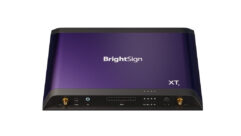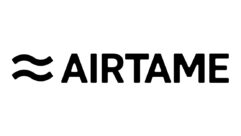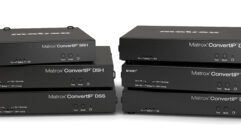
Technology Showcase:
Digital Signage Hardware
May 1, 2006 12:00 PM,
By Jay Ankeney
Today’s large- and small-scale signage hardware supports IP transmission, HD resolutions, and more.
In our post-literate world, people are accustomed to getting their input from flashy and eye-catching images on large, glowing displays. But advertisers are becoming increasingly skeptical about the value of placing their commercial investment in broadcast media. First, they recognize that 70 percent of living room screens have access to cable or satellite programming services that earn their subscriptions by eliminating advertising. Also, advertisers are becoming increasingly aware that as a result of the popularity of TiVo and its DVR (digital video recorder) cousins, viewers can now zap past commercials with far greater alacrity than the fast-forward button on their old VCRs allowed.
QuVis Ovation
As digital signage grows in popularity, it has risen out of the retail arena and split into dedicated markets, including doctors’ waiting rooms, bus stations, schools and churches, and even prison systems. Some call it narrowcasting, others electronic billboards, and many are referring to digital signage displays as a “captive audience network.” It’s even reaching into your local digital cinema megaplex. Digital signage in the form of lobby advertising is getting its own designation — several providers are calling it “electronic cinema” to distinguish their presentations from the ones viewed on the digital big screen.
HARDWARE GETS SOPHISTICATED
The modern era of digital signage began with displays being fed from desktop PCs onto ordinary television screens. More recently, the plummeting cost of CRT, plasma, LED, DLP, and LCD displays (accelerated by the burgeoning home theater market) has made digital signage an even more enticing option for companies with messages to communicate. However, the legendary unreliability of those original PC platforms has induced installers to look for more stable hardware-based options; these devices are less susceptible to the “blue screen of death” system errors that herald a desktop operating system’s demise. In response to this dread, many new digital signage systems come with proof-of-operation logs that can verify the unit’s uninterrupted operation to clients.
In addition, a spreading trend is to control these dedicated systems over IP so their content and display can be changed from anywhere with a web connection. This means that digital signage displays now can be tailored to the interests of their intended audience. This flexible interactivity is something that installed billboards or even pre-scheduled television broadcasts cannot rival. With the option of attracting their audience’s attention by interspersing short entertainment segments between extended content messages, digital signage systems are turning the programming paradigm of conventional AV communication on its head.
This now also extends to RF delivery capabilities (in addition to IP, WAN, or LAN distribution) to the intended display. Since the FCC has mandated that every large HD-capable display with a tuner (what many people call a high-definition TV set) must come with a built-in digital tuner, this provides digital signage hardware manufacturers with a less expensive method of sending their messages over existing RF cabling — just like any other television signal. Given the number of conventional displays already installed in stores, stadiums, schools, and houses of worship, the RF delivery capability is an option that is sure to give digital signage an even wider ability to become a star on the most sophisticated screens.
As a result, the market research firm iSuppli has said that the digital signage market is gaining more credibility and visibility as an increasing number of commercial establishments are implementing digital signage for information, advertisements, and entertainment. In 2004, the total value of displays in the worldwide retail signage market amounted to $664 million. iSuppli estimates the market will grow to $2.35 billion in 2009, rising at a compound annual growth rate of 20 percent since 2004.
That’s a lot of eyes watching a lot of screens, and here are some of the hardware-based solutions that are going to bring it to you reliably.

Cabletime MediaStar Evolution
THE MARKET
Evolution is Cabletime’s brand-new addition to its MediaStar family of TV and video distribution systems. MediaStar Evolution was designed to allow efficient digital video delivery over IP-based networks. It combines digital video streaming and multimedia content delivery across a LAN and WAN network, with analog overlay, to provide realtime displays wherever a twisted-pair infrastructure can reach. MediaStar Evolution encoders support an innovative dual-stream feature that allows a high-bit-rate stream to be delivered to large displays while a simultaneous low-bit-rate stream is delivered to desktop PCs.
Cabletime’s 760/2M Evolution digital signage player runs on an embedded Linux operating system. Its IP browser, RS-232, and USB control interfaces are capable of rendering MPEG-2 or MPEG-4 files retrieved either from a centrally located video server or a USB key, or content downloaded to PCMCIA hard drives. This flexible connectivity also accepts local inputs from a TV, DVD, or VCR, which can be delivered via Cat-5 from a MediaStar Compact system and interspersed with AV playout files on the display. Extra options on the 760/2M include an onboard static Flash memory of 2GB that can be expanded to 8GB, and a plug-in hardware interface to support standard Smart cards and PCMCIA Type II devices such as solid-state memory, hard drives, and wireless interconnectivity modules. MediaStar Evolution is scalable from a single endpoint up to multiple networks with thousands of individual displays.
Based on its experience with broadcast graphics technologies, Chyron claims its ChyTV goes beyond digital signage to “video signage” by emphasizing the inclusion of moving video elements. To attract the viewer’s eye, ChyTV-connected signs display a variety of graphic and text information integrated with a region of live or prerecorded video. All graphic pages can be controlled individually using a schedule that permits looping based on duration or specific days of the week and time of day. In addition, ChyTV signs offer the ability to integrate WAV audio files for sound effects, sound clips, or voiceovers. Laid into pre-canned templates supplied by Chyron, the video elements could range from images of a live event happening at the other end of a mall to a professional entertainment recording. With USB and Ethernet external data interfaces, this signage display can include realtime updates such as news, sports, stock data, and weather.

Chyron ChyTV Plus
For more complex installations, Chyron’s newest ChyTV Plus system includes a full complement of component video, S-Video, composite video, and stereo audio inputs and outputs to allow interfacing with any video sources and displays. ChyTV Plus can be controlled by other devices over either RS-232 or GPI interfaces. As examples, the playlist in ChyTV Plus can be programmed to turn the video display on or off at a designated time, or you can remotely trigger a customer-queueing system or an alarm page in case of a fire. Fully compatible with all ChyTV models, the new ChyTV Plus video information display system can change any television into a dynamic communicator by displaying a message tailored to a specific audience — on any CRT or flatscreen. You can even mix this message with any video content — whether from cable TV, off-air, satellite, DVD, or media player.
Chyron has also developed a digital signage system called ChyAlert, based on the ChyTV system. ChyAlert is a specialized video appliance designed specifically for automated and/or manual display of emergency and security alert graphics, text, and audio in a video distribution display or CATV systems. ChyAlert adds realtime emergency alert messages to any video source.
The FCC has required that digital tuners be included in all large-screen HDTV display devices that can accept an ATSC signal. With that in mind, the SignStream digital signage system from Contemporary Research employs an integrated digital signage server that broadcasts control and HDTV/NTSC content to digital displays and analog TVs with an ATSC-compliant digital tuner. That means the high-definition content gets sent out as a normal HD channel over a standard RF cable.
Signage distribution with the Contemporary Research system begins with the SSV-200, a 2RU rack-mountable server with internal modulator that converts the MPEG-2 files for broadcast into both digital ATSC and analog NTSC channels.
Onboard SignStream software integrates control commands and playlists with its onscreen setup and diagnostic tools and sends them through the same RF coax as the HDTV signage display controllers. Thanks to its open-architecture design, SignStream can integrate controls over RS-232 and infrared, and integrate controls for Smart-format displays and TVs. For maximum flexibility, SignStream servers can run media by themselves, or integrate with other signage systems to feed thousands of displays. By unifying HD media distribution to a single server for control and content and sending the content over existing RF cable infrastructure to multiple displays, SignStream can significantly reduce the cost of digital signage installations.
Behaving just like a website, the DN-V755 network AV player from D&M Professional lets you control the system and add media from any Internet connection just by dragging and dropping files from a computer desktop or a network. Upon power up, the DN-V755 negotiates with a network DHCP server and automatically assigns itself an IP address within a company’s outlined network neighborhood. All aspects of designing and scheduling playlists and managing the DN-V755’s settings are accomplished using three onboard, easy-to-navigate web pages. Playlists can even be built and maintained simply by pointing and clicking on the desired content in the order you want. Then the DN-V755 lets the signage manager simply navigate back to the unit’s home page and launch the designated message to play.
RSS (Really Simple Syndication) feeds are an increasingly popular method for sharing web content, thanks to their widespread availability. Now the HD FrEND Plus MS 9500 from the Media Networks Division of Electrosonic can include up to 10 concurrent RSS transmissions with alpha blending. This lets the operator present a picture keyed behind the RSS feed’s text (which can be in any desired font or size). Powered by an embedded Windows XP operating system that makes it a true high-definition appliance, the HD FrEND Plus now has a built-in front-panel display for ease of operation using ESCAN software for external content control and iMediate software for scheduling. Electrosonic’s HD FrEND Plus includes 40GB of internal hard drive storage that provides more than three hours of content for playout.

MagicBox Aavelin
Enseo calls the core infrastructure of its servers Digital Media Engines, and its Galileo HD MPEG server has been designed specifically for multichannel high-definition video on demand, digital signage, and kiosk marketing applications. You can see them in AMC theaters, where they’re used for Digital Theater Display System pre-show advertising (a.k.a. “electronic cinema”). Based on Enseo’s Alchemy HD MPEG decoder subsystem and Linux Video Suite software, Galileo combines 1080p digital video and graphics along with robust applications software to deliver highly compelling content. Galileo features MP3 decode, AC3 decode, AAC decode, and balanced analog audio (or digital audio) support, cross-conversion of content and resolution formats, and simultaneous decode of four independent streams of high-definition or standard-definition MPEG video content. The Galileo HD MPEG server benefits from simple integration of control devices that send commands over IP.
The Aavelin digital signage and video messaging system from MagicBox (formerly Sound Concepts) is actually made of two parts. The Aavelin Composer software can create dynamic digital messages on a desktop PC. These messages are then “published” over a network connection to a dedicated player unit running on a multi-threaded BeOS operating system. MagicBox’s high-definition model, the AV400 Aavelin HD, features a high-resolution VGA output for driving today’s biggest plasma and LCD displays. It’s a standalone unit designed for 24-hour playback with virtually unlimited (10,000-plus) page capacity. The AV400 can present up to four simultaneous crawl lines and offers smooth, dynamic transitions. One of the latest new features of the AV400 Aavelin HD is its ability to handle Macromedia Flash files which, in addition to being smaller than MPEG, give Aavelin content a look that is different from images typically seen on TV.
A company best known for its digital cinema servers, QuVis has become famous for its high-end digital signage installations. These include the big screens in Madison Square Garden, which use the company’s legacy QuBit servers. Now the QuVis Ovation, the company’s first player-only server, can handle up to 50 video formats ranging from NTSC and PAL up through HD, 2K, and beyond. Its slim, rack-mountable design incorporates 1-1000X search speed and an RS-232/422 interface for remote PC control.
The QuVis Ovation can be configured to play more than 10 hours of 1080i or 720p HD video from internal storage and offers expandable external storage capabilities. It can even swap between different formats without shutting down. With realtime 3D support at a variety of resolutions, the QuVIS Ovation can incorporate frame-accurate synchronous playback for 360-degree domed cinema and other multiple-screen presentation applications.
Symon wants users to think of its TargetVision digital signage solutions as in-store television channels. In its signage solutions, Symon emphasizes the flexible sharing of retail information of all kinds, including advertising campaigns, local news, weather, and targeted sales messaging that all can be configured and monitored over the Web. Symon’s digital signage system involves a combination of the Symon Enterprise Server (SES), Symon Design Studio, and the Symon SDA series of networked video appliances.
Now in its eighth major version, the Symon Enterprise Server acts as the central intelligent hub of the realtime messaging framework. It collects information according to customized business needs and distributes it to numerous endpoints from a single source. Symon Design Studio provides pixel-by-pixel control of the placement, position, and size of all elements in a message’s design, and its output can be streamed and monitored over IP.
There are now four variations of the Symon SDA series of IP-connected network video broadcast appliances. These are store-and-forward devices, so any message they have already downloaded will continue to play even if the whole network goes down. The SDA-100 is intended for low-end installations that require only TV-quality imagery on a single screen, while the SDA-300 raises that output capability to three separate windows. The SDA-600 comes with a live TV option and enhanced resolutions up to 1280×960 in a 4:3 aspect ratio. The SDA-900 includes a powerful Nvidia graphics card for up to 1280×1024 high-definition resolution for true HD images. It can present two separate content streams on multiple displays. With these Symon SDA network appliances in place, each display across the enterprise can be programmed individually by using different layouts and content to fit the needs of specific audiences and environments.
For More Information
Cabletime
www.cabletime.com
Chyron
www.chytv.com
Contemporary Research
www.crwww.com
D&M Professional
www.d-mpro.com
Electrosonic Media Networks
www.electrosonic.com
Enseo
www.enseo.com
MagicBox
www.magicboxinc.com
QuVIS
www.quvis.com
Symon
www.symon.com










